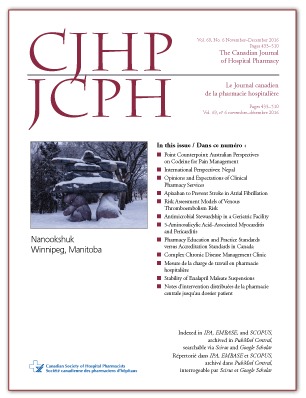Characterization of Venous Thromboembolism Risk in Medical Inpatients Using Different Clinical Risk Assessment Models
DOI:
https://doi.org/10.4212/cjhp.v69i6.1608Keywords:
thromboprophylaxis, venous thromboembolism, Padua Prediction Score, IMPROVE assessment models, thromboprophylaxie, thromboembolie veineuse, score prédictif de Padua, modèles d’évaluation IMPROVEAbstract
ABSTRACT
Background: Symptomatic venous thromboembolism (VTE) occurs in about 1% of patients within 3 months after admission to a medical unit. Recent evidence for thromboprophylaxis in an unselected medical inpatient population has suggested only a modest net benefit. Consequently, guidelines recommend careful risk stratification to guide thromboprophylaxis.
Objectives: To compare candidacy for thromboprophylaxis according to 4 risk stratification models: a regional preprinted order (PPO) set used in the study institution, the Padua Prediction Score, and the IMPROVE predictive and associative risk assessment models.
Methods: A retrospective review of health records was undertaken for patients with no contraindication to pharmacologic thromboprophylaxis who were admitted to the internal medicine service of a teaching hospital between April and July 2013.
Results: Of the 298 patients in the study cohort, 238 (80.0%) received pharmacologic thromboprophylaxis on admission, ordered according to the regional PPO. However, according to the Padua and the IMPROVE predictive risk assessment models, only 64 (21.5%) and 21 (7.0%) of the patients, respectively, were eligible for thromboprophylaxis at the time of admission. On the basis of risk factors identified during the subsequent hospital stay, 54 (18.1%) of the patients were eligible for thromboprophylaxis according to the IMPROVE associative model. Chance-corrected agreement between the PPO and the published risk assessment models was generally poor, with kappa coefficients of 0.109 for the PPO compared with the Padua Prediction Score and 0.013 for the PPO compared with the IMPROVE predictive model.
Conclusions: These data suggest that quantitative models such as the Padua Prediction Score and the IMPROVE models identify more patients at low risk of venous thromboembolism than do in-hospital qualitative risk assessment models. Adoption of these guideline-based risk assessment models for predicting thromboembolic risk in medical inpatients could reduce the use of pharmacologic thromboprophylaxis from 80% to as low as 7%. Further external prognostic validation of risk assessment models and impact analysis studies may show improvements in safety and resource utilization.
RÉSUMÉ
Contexte : La thromboembolie veineuse symptomatique se produit chez environ 1 % des patients dans les trois mois suivant leur admission à un service médical. Des données récentes portant sur la thromboprophylaxie chez une population non sélectionnée de patients hospitalisés ne suggéraient qu’un modeste avantage. Par conséquent, les lignes directrices recommandent une stratification du risque rigoureuse pour guider l’emploi d’une thromboprophylaxie.
Objectifs : Comparer l’admissibilité à la thromboprophylaxie en fonction de quatre modèles de stratification du risque : un ensemble d’ordonnances préimprimées adopté dans une région et utilisé dans l’établissement à l’étude, le score prédictif de Padua et les modèles prédictifs et associatifs d’évaluation du risque issus de l’étude IMPROVE.
Méthodes : Une analyse rétrospective des dossiers médicaux a été menée auprès des patients ne présentant pas de contre-indication à la thromboprophylaxie médicamenteuse qui ont été admis au service de médecine interne d’un hôpital universitaire entre avril et juillet 2013.
Résultats : Parmi les 298 patients de l’étude de cohorte, 238 (80,0 %) ont reçu une thromboprophylaxie médicamenteuse au moment de l’admission, prescrite conformément à l’ensemble d’ordonnances préimprimées en usage dans la région. Or, respectivement selon les modèles prédictifs d’évaluation du risque Padua et IMPROVE, seuls 64 (21,5 %) et 21 (7,0 %) des patients étaient admissibles à la thromboprophylaxie au moment de l’admission. En fonction de facteurs de risques identifiés pendant le séjour subséquent à l’hôpital, 54 (18,1 %) des patients étaient admissibles à la thromboprophylaxie selon le modèle associatif IMPROVE. L’accord corrigé pour le hasard entre l’ensemble d’ordonnances préimprimées et les modèles d’évaluation du risque publiés était généralement faible, les coefficients de kappa étant de 0,109 pour l’ensemble d’ordonnances préimprimées comparé au score prédictif de Padua et de 0,013 pour l’ensemble d’ordonnances préimprimées comparé au modèle prédictif IMPROVE.
Conclusions : Ces données suggèrent que les modèles quantitatifs comme le score prédictif de Padua et les modèles IMPROVE permettent de dépister plus de patients qui sont à faible risque de thromboembolie veineuse que ne le permettent les modèles qualitatifs d’évaluation du risque propres aux hôpitaux. L’adoption de ces modèles d’évaluation du risque mis de l’avant dans des lignes directrices pour prédire les risques d’événements thromboemboliques chez les patients médicaux hospitalisés pourrait réduire l’utilisation de la thromboprophylaxie médicamenteuse, qui pourrait passer de 80 % à aussi peu que 7 %. De plus amples validations externes quant à la valeur prédictive des modèles d’évaluation du risque et des études d’analyse d’impact pourraient montrer des améliorations à la sécurité et une réduction de l’utilisation des ressources.
Downloads
Published
Issue
Section
License
Copyright © Canadian Society of Healthcare-Systems Pharmacy.
After publication of a manuscript in the CJHP, the authors of the manuscript must obtain written permission from the CSHP (publications@cshp.ca) before reproducing any text, figures, tables, or illustrations from the work in future works of their own. If a submitted manuscript is declined for publication in the CJHP, all said rights shall revert to the authors. Please note that any forms (e.g., preprinted orders and patient intake forms) used by a specific hospital or other health care facility and included as illustrative material with a manuscript are exempt from this copyright transfer. The CJHP will require a letter from the hospital or health care facility granting permission to publish the document(s).










